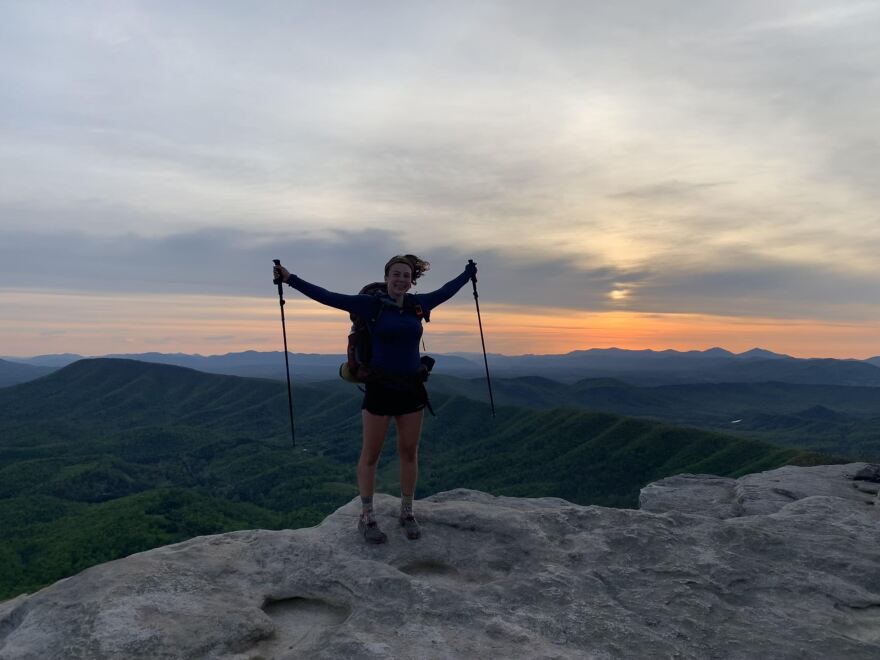About a half mile off the Appalachian Trail in Shenandoah National Park, Stephen Rust is having dinner near a fire with a group of hikers. Rust, like many long distance hikers, is searching for something more than the great outdoors. He introduces himself as “Second Chance.”
“I'm trying to hunt down those second chances, you know, besmirching my good trail name,” he said.
Thru-hikers earn their “trail name” attempting to hike the whole length of the trail. Lengthwise, it's just 2,190 miles long and passes through 14 states. It takes about six months to hike.
Spending time outside is one of the safest activities during Covid, but last year restrictions took thru-hikers off the trail.
This year though, Rust is one of the many hikers that came back, pushing the number of thru-hiker probably above pre-pandemic levels, according to hikers and businesses catering to them along the trail.
"When I got off the trail last year, it felt like the right and wrong choice at the same time,” Rust said. “Then this year, there was determination, mixed with a lot of apprehension.”
Rust got off the trail about 70 miles in last year, but decided it was safe enough this year for him to return to the trail to look - again - for some meaning and direction in life.
“I decided I was tired of this, falling into the same rut that I was putting myself into. And I was always afraid of change. So I figured the AT [Appalachian Trail] was a safe way for me to get out of my own personal bubble,” he said. “The apprehension is starting to wash away now, you know? It's just that determination... I got to hit this goal for myself and it's starting to feel more normal.”
Different pandemic considerations are presenting other thru-hikers their own opportunities to look for change.

“When I started the trail, I met a ton of people who got about 200 miles in last year and were kicked off,” said Lucy Bergoin. “There's a ton of gap year students on trail.”
Bergoin, known as “Chef,” was tired of - and paying tuition for - online college. She said she had another 17 miles to hike that day, but had stopped to chat with Shannon Foley, aka “Potential Roadkill,” and Kyle Bullins aka “Stew” at a wayside in the national park.
The waysides sell lunch and allow for hikers to carry less food. At a picnic table, the smell of days-old sweat mixed with hot sauce, after another hiker seated next to Bullins doused a sandwich wrap with it.
Hikers often need between 4,000 and 6,000 calories a day, the cost of which adds up. Stimulus checks have helped thru-hikers fund the few pairs of boots, replacement clothes, and hostels needed to complete the long trek.
“Getting like, what? 3000-some dollars from the government has helped a bit, yeah,” he said, as the other hiker moved onto a packaged pastry for dessert.
Returnees like Rust, students like Bergoin, and all the people who were already planning to thru hike in 2021 means this year has big numbers. That matters to people like Alison Coltrane.
“Oh, the pandemic was...it just...not decimated, but it put a real hurting,” she said. “ 2020 was half of 2019 as far as income-wise.”
Coltrane runs the Open Arms at the Edge of Town Hostel in Luray. It's one of the many hiker towns along the trail. Hikers typically come in in a wave, but in trail lingo it's known as the bubble. She picks up hikers and brings them to her hostel and into town.
“They’ll just rest….we also include taking them to restaurants and grocery stores for resupply.”
Coltrane says the bubble is more like a river this year. It’s hard to get an accurate number of how many more are on the trail. One hostel owner further south from Coltrane said it was 30% more than a pre-pandemic year, another said it was 50% more. Coltrane said the same as the hikers - it's not just the pandemic that’s bringing them out.
"Probably 90% are in some sort of transition. They're transitioning from one life event to another. They want to figure things out," she said.
Shane Wells tried to stay on the trail last year but eventually had to trade-in the isolation of a solo hike for the self-isolation of COVID.
“We had plenty of time to think, right? When we were locked up. But situations were different, because you were locked up with [a] spouse or kids or work from home or whatever,” he said. “You didn't have the time to reflect like I do now.
Wells retired at 52, and is looking for his next stage of life.
“On the trail, you're always running from three things: you're either running from rain, or you're running from the sun, if it's too hot, or you're running from yourself. But one thing's for sure…They're all three going to catch up with you.”
Only about a quarter of hikers make it all the way from Georgia to Maine. But how many find what they are looking for along the way is harder to say.
This report, provided by Virginia Public Radio, was made possible with support from the Virginia Education Association.





